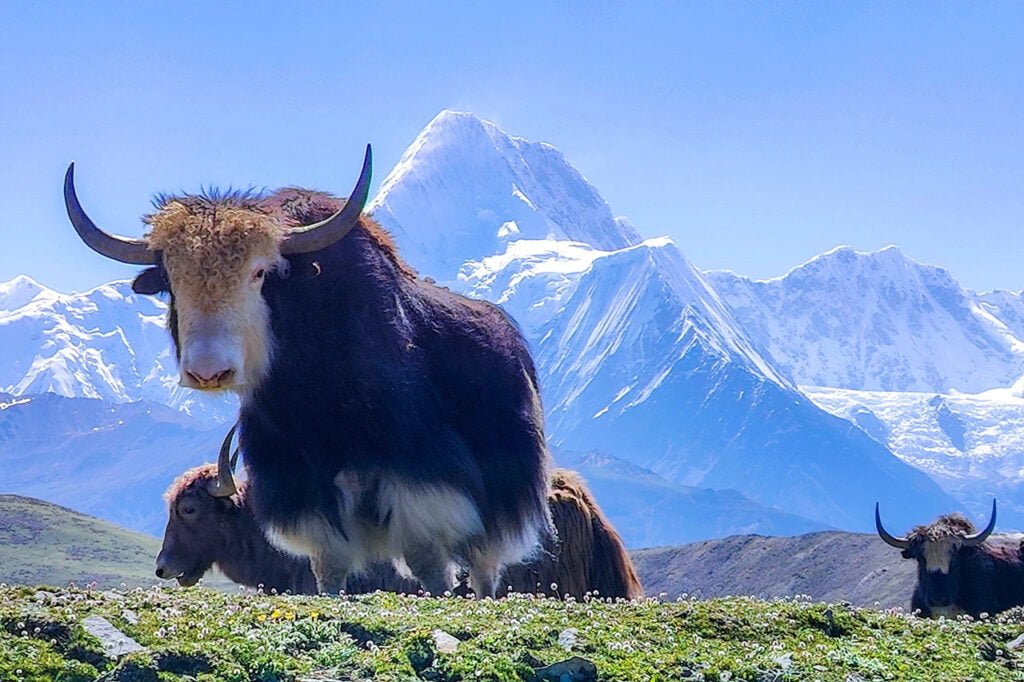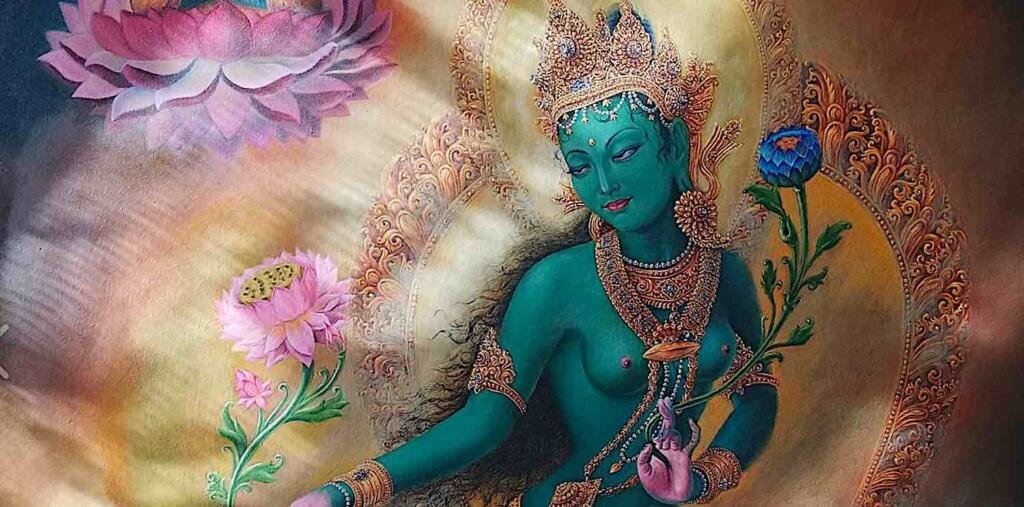In Tibetan mythology, a mystical congregation of ethereal beings existed atop the plateau. Native animals, mythical creatures, and revered deities comprised this extraordinary assembly. Snow lions, Wind Horse, and yaks were resilient guardians of the land. Mythical creatures like Dragons, phoenixes, and Garudas bridged the gap between mortal and divine. Deified animals like Snow Lion, Elephant, and Capricons offered wisdom and inspiration. These beings added wonder to the tapestry of folklore, serving as guiding lights to enlightenment. The Tibetan people found inspiration in the connection between the natural world, the divine, and the human spirit. The presence of these creatures in Tibetan mythology continues to captivate and invite exploration of imagination and wisdom.
Elephants in Tibetan Buddhist arts and mural
There are no elephants in Tibet. They are common in Southeast Asia and are frequently ridden by royal monks. Elephants are also depicted as mounts of gods in Buddhist murals. While there used to be elephants in southern Tibet, they are no longer seen in Tibetan areas due to historical and environmental factors.
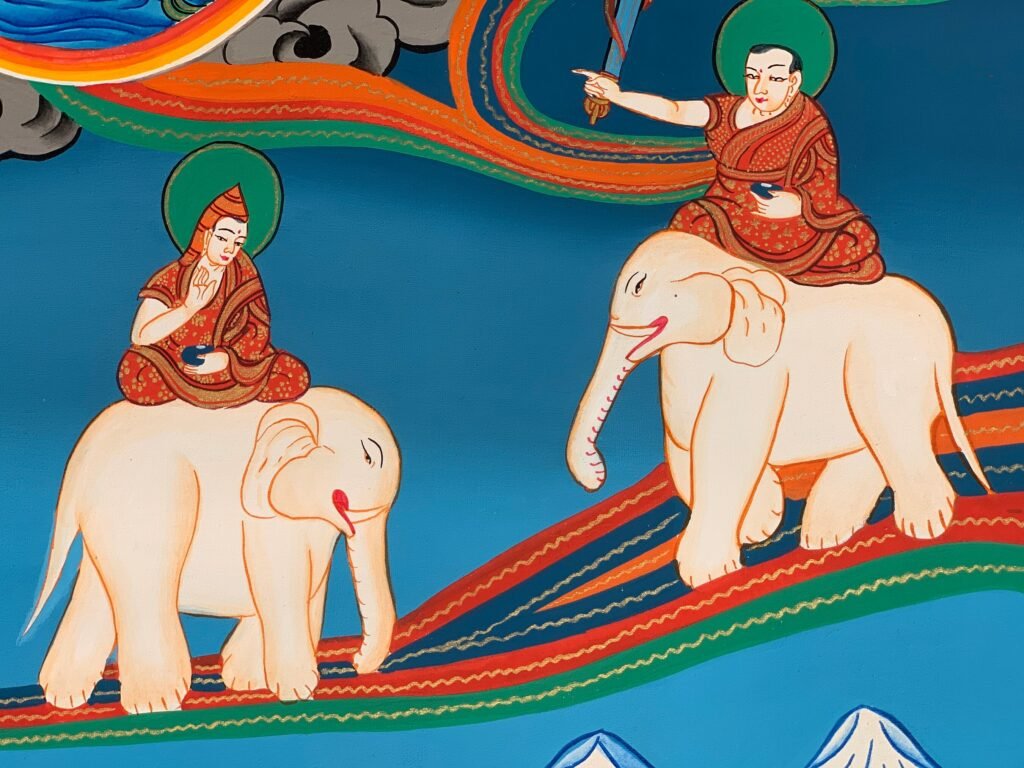
The painting, known as “Acharya, the elephant feeder” is commonly found at the entrance of Tibetan homes. It symbolizes the Buddhist concept of “conquest” and serves as an inspiration for monks and believers on their spiritual journey.
Popular Tibetan animal Yak
The yak is a common domestic animal in Tibetan areas. It embodies the treasures of Tibetan culture. The yak’s ideology has shaped the snowy culture of Tibetans, reflecting values such as honesty, loyalty, compassion, tenacity, bravery, and devotion. For thousands of years, a spiritual depiction of the yak, has been revered in the snowy area. Tibetans hail yak culture as a significant symbol of spirituality and culture. The yak’s spirit has had a profound influence on black-headed Tibetans across generations. Yaks frequently appear in Tibetan opera, adding to the charm of the snowy region.

Horses are beloved creatures in farming and herding, particularly in Tibetan regions. They are not only essential to Tibetan culture but also regarded as carriers of the soul in the primitive beliefs of the Tibetan people.
Wind Horse
Horses in Tibetan regions serve a greater purpose than mere transportation. The wind horse flag, a frequently used blessing instrument, holds significant prominence in Tibetan areas. According to Tibetan beliefs, horses symbolize the primary conveyors of the soul, often uniting with the wind. As running horses are deemed auspicious, Tibetans release wind horse flags at mountain passes, as a testament to their reverence for the soul.
The Bon religion in Tibetan areas is a form of Shamanism that follows the principle of worshipping all things. It includes unique cults dedicated to horses and lights. An important aspect is symbolized by the wind horse flag, which represents the wind and its significance goes beyond mere pieces of paper blown away. Tibetans believe that horses are carriers of the soul and that the wind on mountain tops carries the soul on its final journey. This belief has been present since the early days of the Bon religion.
In addition to these animals that exist in reality, there are also some mythical animals living in Tibet.
The Symbolism of the Tiger in Tibetan Arts
Tigers do not inhabit Tibetan areas, but they are depicted in arts and crafts. However, tigers seldom appear alone on mural thangkas in Tibetan art. Tigers are commonly portrayed as the mount of wrathful deities in Buddhism, symbolizing fear.
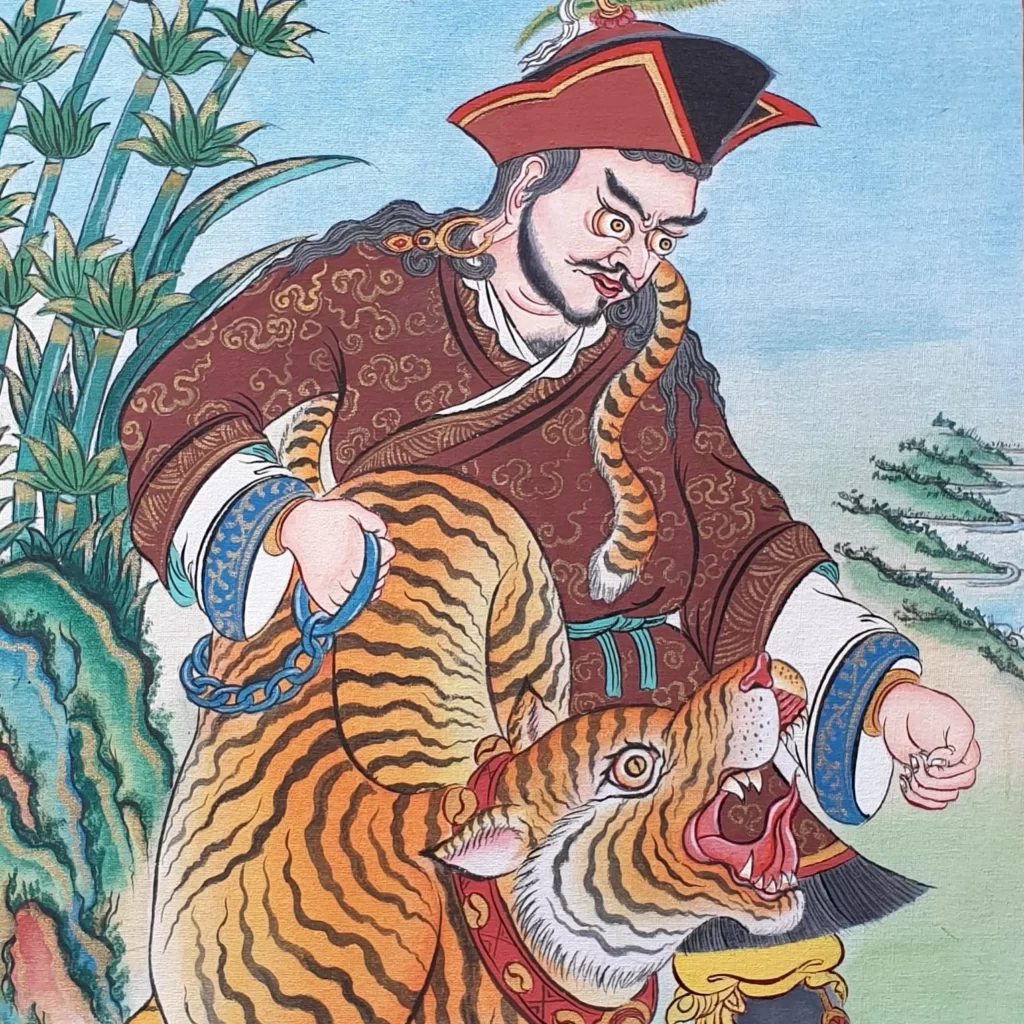
In addition, a more traditional image is the depiction of the Huren subduing the tiger, often found on the Tibetan family’s door wall. There are various theories surrounding its meaning, with some suggesting that it symbolizes the dominance of the Gelug Sect over the ancient religious sect in Tibet.
Tiger skins are worn by wrathful deities to symbolize the subjugation of greed and ignorance. Speaking of tigers, the lion is also a classic image that must be mentioned. Tibetan lions are distinct, with white and green body hair and a bloodied mouth. Early Tibetans believed that these lions were unlucky monsters.
Snow Lion
Tibetans regard the snow mountain lion as their spiritual totem. The so-called snow lion refers to the green-haired lion that lives in the forests and mountains near the snow mountain. Snow lion is a sensitive species, so I won’t introduce it much.
Most snow lions will appear at the base of the Buddha’s throne.

The secret Garuda
There is a half-human, half-bird creature in the snowy region. In ancient India, it was known as Garuda, which is also its name. Simultaneously, it serves as the patron deity of the ancient land of Zhang Zhung, safeguarding its cultural heritage as a spiritual emblem.
Garuda is a fascinating figure in Indian mythology, revered in Buddhism and worshipped in various Southeast Asian countries. In Tibet, Garuda was once the patron saint of the Zhang Zhung Empire. With the introduction of Buddhism, it merged with the Garuda of the Bon Religion, resulting in the unique Garuda belief in Tibet. The Nyingma School holds a profound belief in Garuda, performing numerous Garuda rituals. Garuda is known as the natural enemy of snakes, often depicted gripping a snake in its mouth and stepping on others. Southeast Asia continues to view Garuda as the patron saint capable of confronting snake disasters.

Garuda, often seen above the backlit flames of Buddha statues, is one of the most important Buddhist protectors.
Dragon
The belief in dragons assimilated into Indian Buddhism, deriving from early Indian mythology and evolving from the belief in snakes. Dragons, regarded as mythical creatures dwelling in the sky and underground water, possess the ability to manipulate the weather. According to Tibetan tradition, urinating in springs is believed to bring about afflictions like smallpox, perceived as a retribution imposed upon dragons.
Nagas are believed to guard hidden treasures beneath the earth. Legend has it that Nagarjuna Bodhisattva visited the Dragon Palace and retrieved the Heart Sutra and prayer wheel promptly. It is considered one of the earliest terma. Additionally, the dragon image frequently adorns thrones.
The tiger, snow lion, garuda, and dragon images frequently appear in the four corners of the prayer flag and wind horse flag. They are considered the protectors of Tibetan regions and are believed to safeguard the sacred snowy land. Tibetans associate dragons with thunder and lightning. Additionally, the Tibetan understanding of “dragon” corresponds to the “Lu” of the Water people.
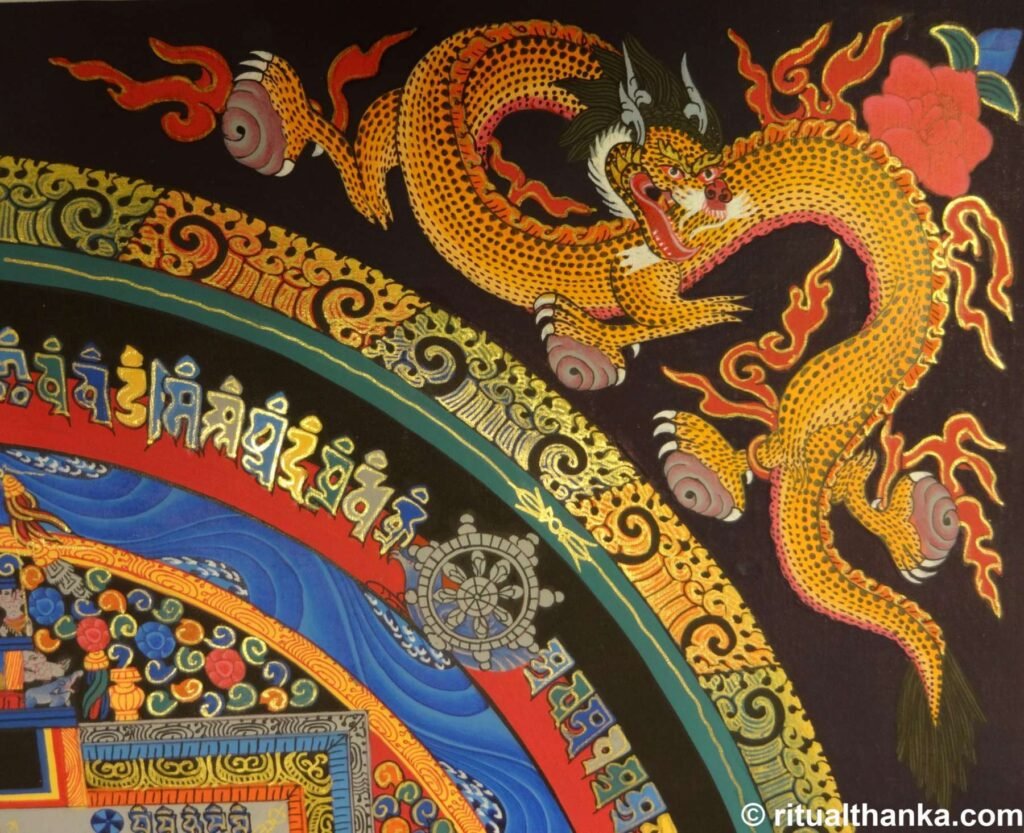
The dragon is a god-like image, and its embodiment in the human world is a snake. In Tibetan regions, “Lu” is depicted as a female figure with both human and dragon characteristics, with a snake coiled around her back. The renowned “Dragon King Pond” located behind the Potala Palace in Lhasa, Tibet serves as a temple dedicated to the worship of the “Dragon King” in Buddhism. Legend has it that she originates from the picturesque valley town of Mozhugongka.
Let me introduce a more interesting one, which is Capricorn in the zodiac.
Capricorn
The water beast Capricornus is native to India and is regarded as a composite creature. It is commonly depicted in Buddhist artefacts within Buddhism. Numerous ceremonial instruments feature blades that protrude from Capricornus’s mouth. It embodies three distinct forms: an elephant trunk, a dragon head, and a fish body. Capricornus is prevalent in various aspects of Tibetan culture and art, including murals.
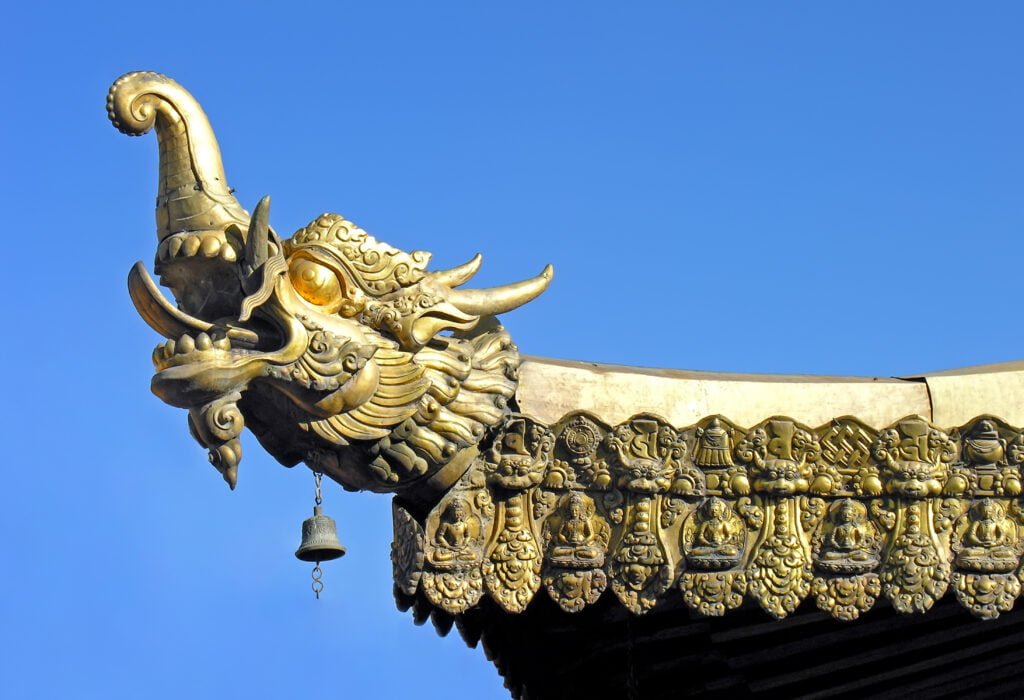
Capricornus is a powerful weapon used by angry gods in Thangka art. It is also revered as a deity by certain protectors. Statues of water beasts can be found on the corners of certain buildings, symbolizing Capricornus and ensuring their protection from fire. Its presence represents the Tibetan longing for water and the sea, as well as instilling fear and fulfilling its duty of safeguarding the Dharma.


